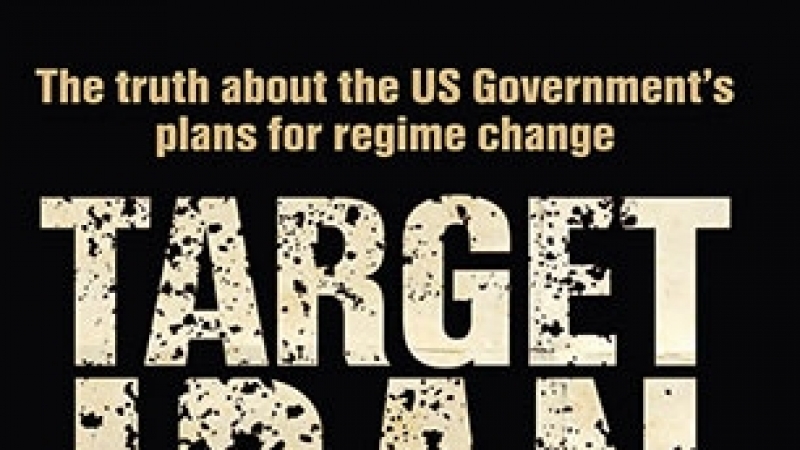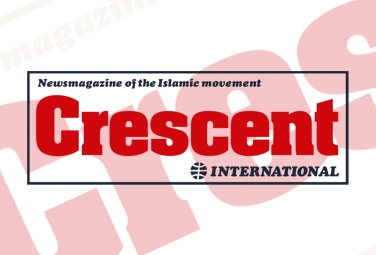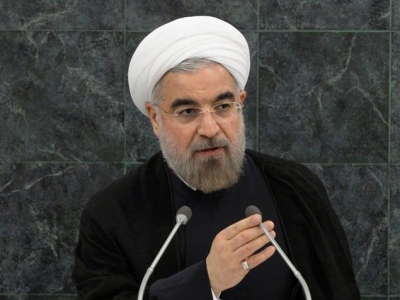The truth about the US’s plans against Islamic Iran
Empowering Weak & OppressedCrescent International
Jumada' al-Ula' 15, 1428 2007-06-01
Book Review
by Crescent International (Book Review, Crescent International Vol. 36, No. 4, Jumada' al-Ula', 1428)

Target Iran: The Truth about the White House's Plans for Regime Change by Scott Ritter. Pub: Nation Books, New York, 2006. Pp: 316. Hbk: US$25.95.
Target Iran is the latest book by Scott Ritter, one of the UN’s top weapons inspectors in Iraq between 1991 and 1998. He is the author of many books, including Iraq Confidential (2005), in which he revealed how the CIA deliberately sabotaged the activities of the UN Special Commission on Iraq. An integral, independent inspector, Ritter insisted over and over again, in 2002 and early 2004, that there were no weapons of mass destruction in Iraq. The US, however, was only using allegations of weapons of mass destruction as a pretext to pursue its real aim: regime change. Seeing history repeat itself before his very eyes, Ritter has written Target Iran with a sense of urgency, hoping that his call from the wilderness will not go unheeded again.
Ritter’s book is based on IAEA reports, media accounts, and his extensive contacts among academics, weapons inspectors, nuclear experts, intelligence officials, and diplomatic sources. Target Iran reveals that the present Iranian crisis was manufactured in Israel, an effort spearheaded by Major-General Amos Gilad, senior advisor to Israel’s Minister of Defence. Rejecting the disciplined approach that Israeli military intelligence had embraced since 1973, Gilad moved from fact-based analysis to faith-based konseptsia. He took on the task of elevating Iran to the state of number one threat facing Israel, overseeing the 1996 National Threat Assessment which called for regime change in Iran. Amos Gilad then engaged the services of the pro-Israeli lobby, the American-Israeli Public Affairs Committee (AIPAC), in order to bring the battle to the US Congress.
History, of course, was repeating itself. Amos Gilad, along with Israeli intelligence, had plenty of experience manipulating American political opinion against Syria and Iraq. He had previously placed Iraq as the number one threat facing the state of Israel, unleashing the propaganda campaign which eventually led to the overthrown of Saddam Hussein. In February 2003, Amos Gilad made one of his most outlandish allegations, claiming that Saddam “kept astounding quantities of chemical weapons aimed at half the world. He apparently also has biological weapons and is engaged in building nuclear weapons.” As Ritter explains, the statement was stunning since it was not backed by any serious assessment from within the Israeli military system.
Despite the fact that the Israeli-supplied information against Iraq had been manufactured, it was presented as fact by the fear-mongering Bush administration. Vice President Dick Cheney claimed that “Saddam has resumed his efforts to acquire nuclear weapon,” that “Saddam will acquire nuclear weapons fairly soon,” and that “he is using his procurement system to acquire the equipment he needs in order to enrich uranium to build a nuclear weapon”. Condoleeza Rice claimed that Saddam had the infrastructure and nuclear scientists to make a nuclear weapon and that he was only six months away from making a crude nuclear device. Dismissing United Nations Special Commission (UNSCOM) inspectors who found no evidence whatsoever of a nuclear programme in Iraq, Rice claimed that “there will always be some uncertainty about how quickly he can acquire nuclear weapons. But we don’t want the smoking gun to be a mushroom cloud.” Even though Mohammed El-Baradei, the Director General of the International Atomic Energy Agency (IAEA), refuted every single allegation made by the USregarding an Iraqi reconstituted nuclear program, his calls for calm fell on deaf ears. The decision to destroy Iraq had long been made in both Israel and the US. The UN weapons-inspection process had long been hijacked by the US, using it as a justification for military action against Iraq. Since lies lead to more lies, the reasons for invading and occupying Iraq have continued to morph: 9/11, the war against terror, weapons of mass destruction, freedom and democracy…
Although Ritter clearly understands the Israeli agenda against Iraq and Iran, he should also have stressed the Syrian-Lebanese situation. After the invasion of Iraq, Israeli intelligence intensified its propaganda against Syria and Iran. In April 2003, Amos Gilad said that “Now that Saddam Hussein’s regime has collapsed, it’s time for a change in Syria too.” On February 14, 2005, Lebanon’s former Primer Minister, Rafiq Hariri, was assassinated by the Mossad in Beirut, unleashing events that had been orchestrated for years by the Israel and US intelligence: a “popular” uprising against the Syrian “occupation” which was coined the “Cedar Revolution” by US undersecretary of state for global affairs, Paula J. Dobriansky in a news conference. Lacking the sophistication of the Israelis and Americans when it comes to world-wide media manipulation and political machination, the Syrians were pressured into withdrawing their 14,000 troops from Lebanon on April 27, 2005. The aim of this operation was not to bring freedom and democracy to the Lebanese, but rather to facilitate an Israeli invasion of Lebanon which took place in July of 2006. Lebanon and Syria, of course, were only part of the pie. The Zionist set eyes on the big baker, Iran, which was seen as the leavening agent in the entire Islamic world. No soon was Saddam Hussein overthrown, that Israeli foreign minister Silvan Shalmo told the UN general assembly that “Iran has replaced Saddam Hussein as the world’s number one exporter of terror, hate and instability.” Following the lead of Amos Gilad, the Bush administration’s 2006 National Security Strategy listed Iran as the greatest threat to the United States, claiming that it was in violation of the Non-Proliferation Treaty (NPT).
Although Ritter possesses pieces of the puzzle, he has not completely put them together. As part of its paranoia, Israel believes that it is in a state of perpetual war. While the early zionistsopenly advocated the creation of a Greater Israel, from the Nile to the Euphrates, they soon realised that such a goal was not attainable militarily. Rather than focusing on physical force in all circumstances, Israel invested enormously in its intelligence service, seeking to influence and eventually dominate regional powers. There was no need for annexation if Israel could get engaged to Egypt, sleep with Saudi Arabia, “get jiggy” with Jordan, elope with the Emirates, kiss Kuwait, tongue-twist Turkey, and make love to Morocco. As for those who fail to submit to Israeli seduction, they will simply be violated by means of regime change in order to create a buffer zone. Like a mercenary mistress, America has offered its services, reshaping the Islamic world, to protect its persuasive pimp. Israel, of course, understands its image and lack of credibility. In order to advance their agenda against Iran, the Israelis have used intermediaries which include the Kurds loyal to Mustafa Barzani, the Mujahidin-e Khalq, and US neo-conservatives.
Kurdish separatists loyal to Mustafa Barzani’s Kurdish Democratic Party (KDP) have long maintained close ties with Israeli intelligence, relations which expanded during the Iran-Iraq. Barzani initiated contacts with Israel in 1963, and military cooperation began in 1965 with Kurdish guerrillas being led into battle by officers from Israel’s military intelligence. Thanks to the Kurd connection, Israel created a number of intelligence-gathering networks in Iran and Iraq. After the 1991 Gulf War, Israel greatly expanded its presence in northern Iraq, using elite teams of spies drawn from the ranks of Israeli Kurds of Iraqi origin which number around 50,000. By 1995, this Kurdish network was providing Israeli intelligence with information regarding Iraqi weapons of mass destruction, evidence which was used to support aggression and invasion against the country. At the same time, of course, Israel was supporting the destruction of the Kurdish rebellion in Turkey. In fact, it was largely due to Israeli intelligence that Turkish authorities were able to apprehend PKK leader Abdullah Ocalan.
Like the separatist Kurds, the People’s Mujahidin of Iran, known as the Mujahidin-e Khalq or MEK, has also been providing Israel with information regarding Iran’s military capabilities for decades. In order to gather public support for the overthrow of the Islamic Republic, Israeli intelligence started to feed false information to the National Council of Resistance in Iran inWashington DC, often using the Israeli lobby as an intermediary. The NCRI, of course, is merely the official façade of the Mujahidin-e Khalq, which is designated as a terrorist organisation by the US, Canada, the EU, and Iran. The Israelis denounce Iran for its support of Hizbullah and Hamas when the Israelis themselves support terrorist groups such as the MEK.
In the US, the Israeli agenda against Iran was further advanced by extreme right-wing think-tanks like the Jewish Institute for National Security Affairs, as well as the Project for the New American Century. Both the JINSC and the PNAC have long advocated the neutralisation of Palestine, Iraq, Iran, Syria, Lebanon, and Libya by means of regime change. Thanks to falsified information fed by Israeli intelligence to counter-revolutionary Iranians, and continued pressure by the America-Israel Public Relations Committee (AIPAC), members of Congress started to express their support for regime-change in Tehran. By the late 1990s, the US government had been convinced of the Israeli way of thinking. With the rise to power of the Republicans in 2000, many leading members of the JINSC and PNAC assumed positions of political power, including: George W. Bush, Dick Cheney, Karl Rove, Richard Perle, James Woolsey, John Bolton, Richard Armitage, Zalmay Khalilzad, Lewis Libby, Donald Rumsfeld, and Paul Wolfowitz, among many more. By 2004 the US House of Representatives had passed resolution 398, which expressed the concern of the Congress over Iran’s development of the means to produce nuclear weapons, and calls upon the president to use all appropriate means to deter, dissuade, and prevent Iran from acquiring nuclear weapons.
Despite the fact that the IAEA concluded that there was no evidence of a nuclear weapons programme in Iran, the head of the Mossad insisted that Iran was on the point of no return.
During a trip to Germany, Donald Rumsfeld claimed that Iran has “a very active program and are likely to have nuclear weapons in a relatively short period of time.” John Bolton claimed that the IAEA report was “impossible to believe” and that it actually proved that Iran was engaged in a “massive covert” effort to acquire nuclear weapons. In his words, “There’s just no doubt that for close to 20 years, the Iranians have been pursuing nuclear weapons through a clandestine program that we’ve uncovered.” According to Ritter, Bolton has leaked Israeli provided information to US media outlets. The CIA, which lied about the existence of an Iraqi nuclear weapons program, continued its campaign of falsehood, claiming that: “Tehran has been pursuing a clandestine nuclear weapons program.” As proof, the CIA stated that its satellites showed Iran actively trying to bury the centrifuge enrichment facility at Natanz.
As Ritter explains, the CIA position is absolutely absurd since the facility in Natanz was under the total monitoring of IAEA inspectors, who reported back that the plant was still very much under construction and engaged in no activity whatsoever. Despite the objections of the IAEA, the Bush administration continues to misrepresent the capabilities of the Iranian uranium-enrichment programme, irresponsibly inserting red herrings in their assessment. The US even claimed that the Shahib-3 missile was designed to carry a nuclear warhead. Since Israeli-US allegations regarding the Iranian nuclear enrichment programme have been proved to be unfounded, their propaganda machines have attempted to cast a broader net. As Condi Rice now says, “it’s not just Iran’s nuclear program, but also their support for terrorism around the world. They are, in effect, the central banker for terrorism around the world.” Iran is now accused of arming insurgents in Iraq, along with a renewal of old accusations: violation of human rights, oppression of women, suppressing democracy and so on.
As Ritter explains, the Iranian nuclear power program dates back to the time of the Shah of Iran. During the mid 1970s, the monarchy decided to install a network of twenty nuclear reactors which would supply the country with all of its energy needs. Iran is a signatory to the Non-Proliferation Treaty and, according to Article IV, has the inalienable right to develop, research, produce, and use nuclear energy for peaceful purposes without discrimination. At present, Iran finds itself embroiled in a very difficult situation. If it walks away from the IAEA, it jeopardises lucrative trade talks with the European Union. The Russians have also made it clear that their assistance is linked to Iran’s continued cooperation with the IAEA. If Iran refuses to cooperate with the IAEA or pulls out of the NPT, Israel and the US will use it as proof of Iran’s culpability. At the same time, the IAEA is infiltrated with Israeli and American agents, who use the inspection programme to acquire sensitive information regarding to Iran’s military capabilities. The hypocrisy of the world community towards Iran is not lost on Ritter. One only has to look to Israel to see the double standard. The Zionist regime has an undeclared nuclear weapons program, and refuses to sign on to the provisions of the NPT. Even El-Baradei admits that Iran is much more forthcoming and cooperative about its nuclear programme than Israel has ever been. Such an important issue never makes it to the mainstream media, which is more concerned with demonising the present Iranian president.
Despite all the outrage caused by Ahmadinejad’s statements against Israel, and all the false allegations made regarding his hostage-holding past, Ritter argues that these allegations cannot be used as grounds to justify war against Iran. In the Islamic Republic, he says, the president has no power whatsoever when it comes to using force against any threat, domestic or foreign. All power resides with the Supreme Leader, Imam ‘Ali Khamenei. As Ritter reveals to those who are unfamiliar with the Iranian political system, whatever the president’s views may be, he has no effective authority to do so without the agreement of the Supreme Leader, whose public position is very different. This is in stark contrast to the paranoid delusions of John Bolton who presents Ahmadinejad as a Holocaust-denier with his finger on a nuclear button. As Ritter points out, Imam Khamenei clarified Iran’s position after Ahmedinejad’s statements had been sensationally misreported, stating that Iran “will not commit aggression towards any nations.” In contrast, while Khamenei calls for calm, President Bush calls for war, openly threatening to use nuclear weapons against friends or foes who challenge US interests. The 2002 National Security Policy states that “the United States…will not hesitate to act alone…by acting preemptively.” When indirectly asked about nuking Iran, Bush stated in September 2003 that “we don’t take options off the table.” In May 2006, John Bolton told B’nai Brith that if Iran did not play ball, it would not be allowed to stay in place.
As Ritter shows, the US and Israel are paranoid players in the Iran crisis, the French and the Germans are appeasers, and the Russians are the only rational players. Interestingly enough, the solution to the crisis will not come from Western powers. According to Ritter, “Ayatollah ‘Ali Khamenei may represent the best hope for a diplomatic resolution of the Iranian nuclear crisis.” As the author explains, Khamenei has reached out to the US on several occasions by means of ambassadorial intermediaries. In its stubborn-minded arrogance, the diplomatically-deficient Bush administration has failed to respond in any fashion. Khamenei, however, was not swayed, and continues to articulate a moderate approach towards resolving the differences between Iran and the US. Strategically silenced by the mainstream media in the Western world, Imam Khamenei seems to be the sole hope for saving Iran.
As Ritter has revealed in his book, “the conflict currently underway between the US and Iran is, first and foremost, a conflict born in Israel. It is based upon an Israeli contention that Iranposes a threat to Israel, and defined by Israeli assertions that Iran possesses a nuclear weapons program. None of this has been shown to be true, and indeed much of the allegations made by Israel against Iran have been clearly demonstrated as being false. And yet the US continues to trumpet the Israeli claims.” The author denounces the unparalleled influence the Israeli lobby exerts over the US Congress and the executive branch of government. He reminds Americans that while many of them may feel compelled to support Israel out of sense of moral duty and obligation, Israel in the end does not share the same moral bond in terms of supporting the United States. As Ritter explains, Israeli security policy makers view America as but a tool to be wielded in support of larger Israeli interests.
Whether reason will prevail remains to be seen. The outlook, however, is far from promising. As Ritter admits, “When it comes time to Iran, the Bush administration ultimately has only a single policy objective: regime change, at any cost.” As the author explains, US military and intelligence officials had reviewed the possibility of a decapitating strike against Iran’s nuclear programme, and the results were not encouraging. Unlike Iraq, Iran does not possess a single target that could be bombed to destroy a nuclear programme. In Iran there are numerous targets, spread out over a vast territory, requiring a massive military effort. According to military planners, a war against Iran lacked the certainty of success, risking a rapid escalation of violence which could not be contained. In short, “according to U.S. military planners, an attack on Iran, even if it was limited in scope to Iran’s nuclear activities, would rapidly spin out of control into a regional conflict that could not be contained.”
The Iranian people are a proud people who cherish their culture history, and independence. Any notion that the Iranian people who somehow stand idly while the United States bombarded their nation or occupied their soil is tragically unfounded. Iran would resist any attack against its soil with all of the considerable means available. Any aerial bombardment of Iran would result in an immediate attack by Iranian missiles on targets in Israel, followed by a major Hezbollah rocketing from northern Israel
Ritter’s conclusion is gripping:
Iran is not Iraq…Iran remains a very modern nation state…with access to the complete spectrum of technologies…This includes military technology. Iran is a vastly larger country than Iraq, with a correspondingly larger population and military. The Iranian people are a proud people who cherish their culture history, and independence. Any notion that the Iranian people who somehow stand idly while the United States bombarded their nation or occupied their soil is tragically unfounded. Iran would resist any attack against its soil with all of the considerable means available. Any aerial bombardment of Iran would result in an immediate attack by Iranian missiles on targets in Israel, followed by a major Hezbollah rocketing from northern Israel. If U.S. military forces were deployed from the soil of any nation within striking distance of Iran, those nations too could be expected to come under Iranian attack. Iran will fire missile barrages against American forces in Iraq, and then engage the entire collation occupation force on the ground…Iran will do its utmost to play the oil card, not only shutting off its exportation of oil and natural gas, but also threaten the oil production of Iraq, Kuwait, UAE, and Saudi Arabia… US naval forces operating in the Persian will be put at risk… There is a better than even chance that Iran would succeed in shutting down the straight [sic.] of Hormuz, chocking [sic.] off the global oil supply…The Iranian reaction will have global reach, with …terror bombings, kidnappings and/or assassinations… Attacks will definitely occur in Europe, and may even spread to American soil…Any American ground invasion of Iran would be doomed to fail…America simply does not have the conventional combat power to fight a sustained ground combat action in Iran…Faced with such a disaster, the United States would have to no choice but to escalate the conflict along military lines, which means engage Iran with nuclear weapons. At this juncture, the equation becomes unpredictable, the damage done incalculable, and the course of world history, including America’s role as a viable global leader.
Ritter’s vision may be realistic; let us hope that it is not prophetic.
This book review was contributed by a Muslim academic in the US who prefers to remain anonymous




